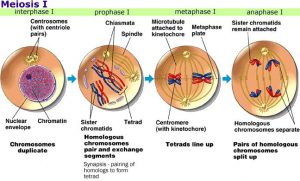Cell Cycle (Meiosis)
Meiosis is the type of cell division involved in the formation of sex cells, or gametes.In humans, this takes place in sex cells ie. testes and ovaries. Meiosis involves two stages of cell division that have some similarities to the phases in mitosis.
Stages of Meiosis
- Meiosis involves two nuclear divisions that produce four haploid cells.
- Meiosis I
- Meosis II
- Meiosis I is usually referred to as the reduction division, since the number of diploids, or 2n, is reduced to the number of chromosomes, or n.
- Step II, Meiosis II is characterised by two chromatids isolation.
- Even meiosis can be represented in the phases used for explaining mitosis cases.
- DNA synthesis happens before the cell division process, as with mitosis.
Meiosis I
It involves:-
1.Prophase
- Leptotene
- Zygotene
- Pachytene
- Diplotene
- Dikinesis
2.Metaphase I
3.Anaphase I
4.Telophase I
Prophase I
It is divided into 5 stages
- Leptotene- The chromosome starts condensing and the nuclear membrane begins to disintegrate.
- Zygotene – The centriole separates, and its portions travel to the opposite poles within the cell, as the spindle fibre is formed. The chromosome consists of four chromatids, called a tetrad in homologous pairs. This is considered the synapsis.
- Pachytene – Chromatids often intertwine as chromosomes synapse . In a mechanism called crossing, often the entangled chromatides of separate homologs break down and exchange fragments. The cross-over happens between non-sister chromatides, allowing genetic materials to be shared between homologous chromosome pairs
- Diplotene – Synapsis concludes with synaptonemal complex disappearances; homologous pairs continue to be linked to chiasmata.
- Diakinesis – until metaphase I, chromosomes are fully condensed and nuclear membrane breaks up
Metaphase I
- The homologous chromosomes attach themselves to the spindle fibres and line up along the equatorial plate.
Anaphase I
- The homologous chromosomes travel into the opposite poles.
- The reduction division occurs at this stage in meiosis.
- One member of each homologous pair will be found in each of the new cells.
- There are two sister chromatids in each chromosome.
Telophase I
- A membrane around each nucleus starts to form.
- In comparison to mitosis , the chromosomes in both nuclei are not the same as the daughter nuclei since they have one individual from the homologous pair of chromosomes.
- Although they are the homologous genes, they are not the same. The genes are of equal characteristics ( e.g., skin colour), but the genes can vary (e.g. brown-eye coding or blue-eye coding).
- The cells are now ready to start the second stage of meiosis.
Then it is followed by Cytokinesis which divide the cell into two equal daughter cells as in mitosis.

Meiosis II
Meiosis II occurs at approximately the same time in each of the haploid daughter cells.
It involves:-
- Prophase II
- Metaphase II
- Anaphase II
- Telophase II
During meiosis II, pairs of chromatids will separate and move to opposite poles. Note that, unlike with mitosis and meiosis I, there is no replication of chromosomes prior to meiosis II
Prophase II
It signifies the starting of the second meiotic division . The nuclear membrane dissolves at this point and the spindle fibres start to form.
Metaphase II
It is signalled by the distribution around the equatorial plate of the chromosomes, each with two chromatids. The centromere remains held together by the chromatids.
Anaphase II
It can be identified by the breaking of the attachment between the two chromatids and by their movement to the opposite poles. This stage ends when the nuclear membrane begins to form around the chromatids
Telophase II
The second nuclear division is completed during this process and then the second cytoplasm division occurs. Four haploid daughter cells from each meiotic division are formed.

No Of Chromosomes
Total Number of chromosomes in meiosis is 23 in each daughter cell. Thus it is called Reductional division
Meiosis in Humans
- The chromosome number of the daughter cells is half that of the parent cell in meiosis.
- A 46-chromosome human cell can undergo meiosis and produce gametes that have 23 chromosomes.
- Same number and form of chromosomes are found in each gamete. The number of chromosomes in a gamete is called the number of the haploid chromosome, or n; in all other cells with a nucleus, the number of chromosomes is double the number of the haploid and is called the number of the diploid, or 2n.
- The haploid chromosome number is 23 in humans and the number of diploid chromosomes is 46.
Offspring carry genetic information from each of the parents. - Each cell in body, except the sex cells, contains 23 pairs of homologous chromosomes, or 46 chromosomes in total. The 23rd pair of chromosomes, which determine sex in mammals, are called the X and Y chromosomes and are only partially homologous. Males receive an X and a Y chromosome and females receive two X chromosomes.
- A haploid (n = 23) sperm cell unites with a haploid (n = 23) egg cell during fertilisation to create a diploid (2n = 46) zygote. The diploid chromosome number in the zygote is recovered by the fusion of male and female gametes. The zygote will start to differentiate through mitosis and ultimately become a human multicellular baby.
References
